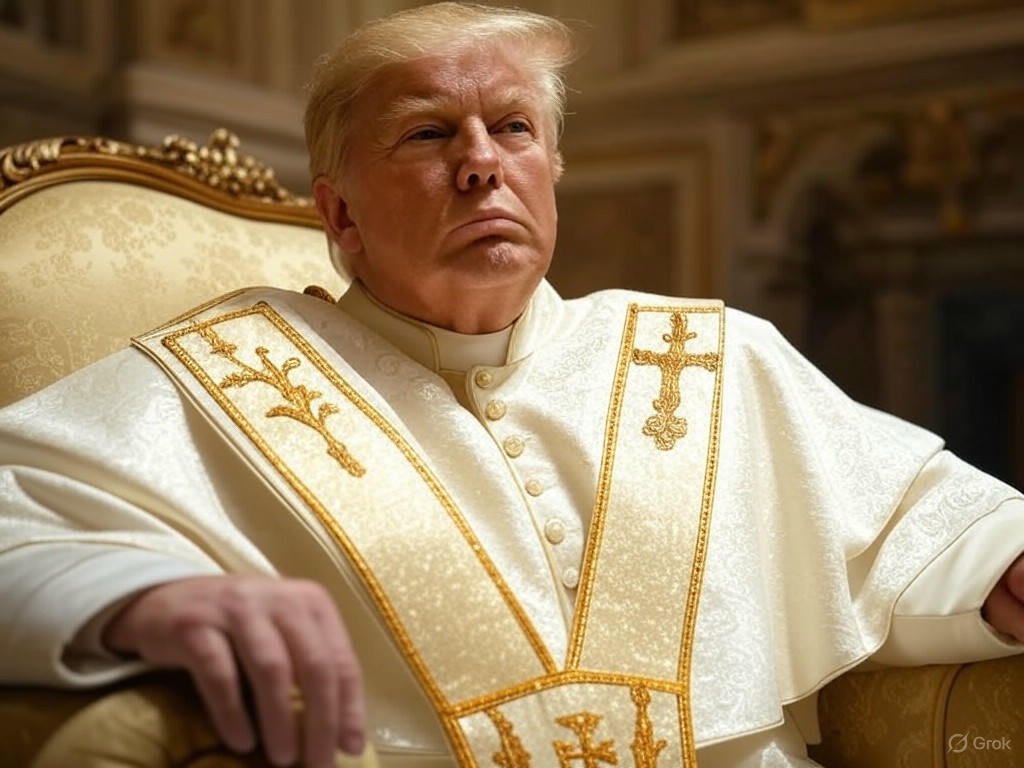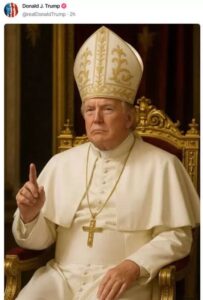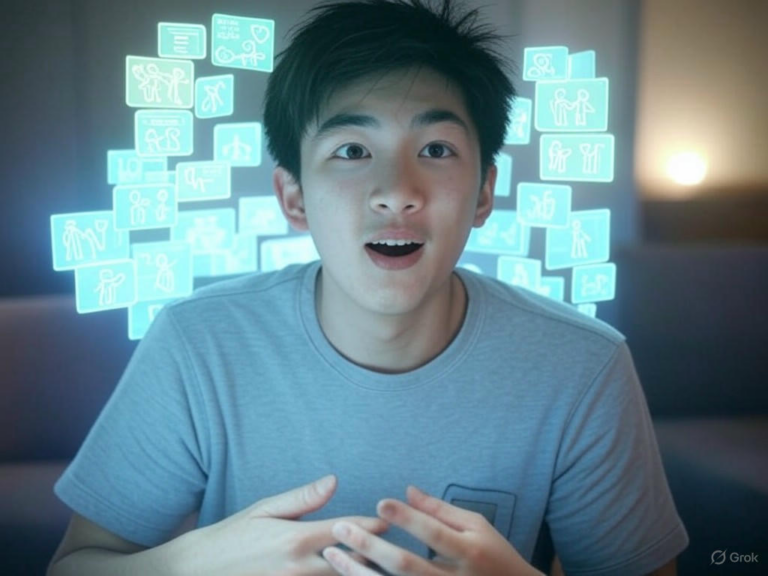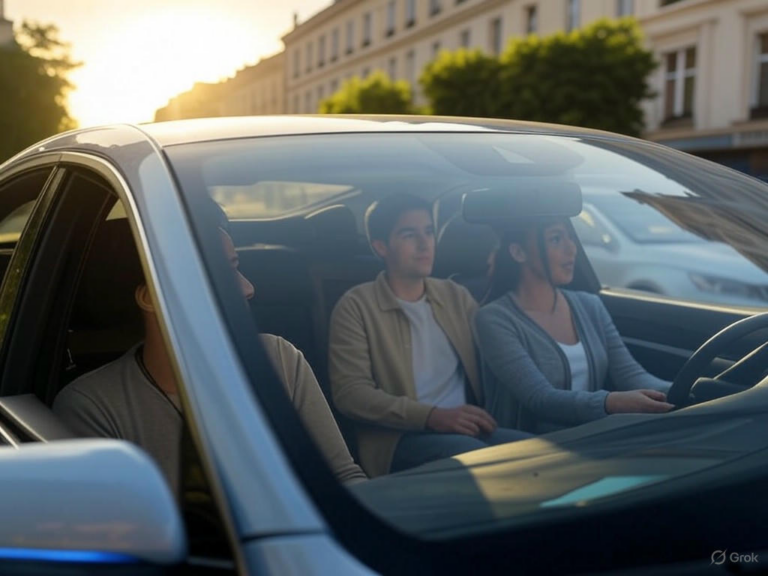
AI-Generated Trump Pope Image Sparks Viral Debate
The Viral Spread of the Trump Pope Image
In the fast-paced world of social media, where images can spark outrage or laughter in seconds, President Donald Trump’s recent share of an AI-generated image has taken center stage. Picture this: Trump seated in an ornate chair, clad in white papal vestments and a headdress, his finger raised as if delivering a sermon. He posted this on Truth Social on May 2, 2025, just days after jokingly telling reporters he’d love to be pope—timing that couldn’t have been more charged.
This Trump Pope image quickly exploded online, drawing millions of views and shares across platforms. Critics called it tasteless, especially since it came only 11 days after Pope Francis passed away at 88 from a stroke-related heart failure, and right after Trump attended the funeral in Vatican City. The White House’s own accounts amplified it, turning what might have been a fleeting joke into a full-blown debate. What do you make of leaders using AI this way—harmless fun or a step too far?
The Trump Pope image underscores how AI tools can blur the lines between reality and satire, sparking conversations about respect and humor in politics. As this image ricocheted around the internet, it highlighted the power of digital content to influence public opinion almost instantly.

Context Behind the Trump Pope Image Controversy
Let’s rewind a bit to understand why this AI-generated Trump Pope image hit such a nerve. It all started with Trump’s offhand remark to reporters earlier that week, where he quipped he’d like to succeed Pope Francis, before naming Timothy Cardinal Dolan as a serious pick. While Trump, a nondenominational Christian raised Presbyterian, meant it as a joke, the follow-up image felt like escalating the punchline.
This isn’t Trump’s first dip into AI visuals; back in February, he shared one of himself as a king to celebrate a policy win. But the Trump Pope image stands out for its sensitivity, given the Catholic Church’s deep traditions and the raw emotions surrounding Pope Francis’s death. Imagine blending politics with religion like this—it’s like mixing oil and water, often leading to a messy spill.
For those unfamiliar, the papal role symbolizes profound spiritual authority, making any lighthearted portrayal feel intrusive. This Trump Pope image, therefore, didn’t just amuse some; it offended many who see the papacy as sacred, especially during a time of mourning and transition.
Debating AI’s Role in the Trump Pope Image
Now, drilling deeper into the Trump Pope image, we see how AI’s ease of use is changing the game. Tools that create these visuals are widely available, letting anyone morph a photo in minutes. But when a figure like Trump uses them, it raises questions about intent and impact.
Critics argue it’s disrespectful, particularly in the context of a religious leader’s passing. Supporters, on the other hand, see it as typical Trump humor. This back-and-forth around the Trump Pope image shows how AI is reshaping how we communicate, for better or worse.
Public Reactions to the Trump Pope Image
The Trump Pope image didn’t just fade into the background—it ignited a firestorm of opinions. On social media, detractors slammed it as mockery of Catholic traditions, with one X user from “Republicans Against Trump” calling it “full-on lunacy.” Democratic voices like Harry Sisson pointed out how this distracted from real issues like inflation, labeling Trump a “man-child” focused on gimmicks.
Yet, not everyone was outraged. Supporters, including Townhall’s Dustan Grage, defended it as light-hearted fun, dismissing critics as out of touch. At Trump’s Florida golf club, fan Debbie Macchia shrugged it off as a joke but drew the line at anything truly sacrilegious. It’s fascinating how the same Trump Pope image can divide people so sharply, depending on their worldview.
If you’re following along, you might wonder: Does political satire have limits, especially with religious symbols? This debate around the Trump Pope image certainly makes you think about where we draw those lines in today’s polarized climate.
The Vatican’s Transition Amid Trump Pope Image Buzz
Amid all this noise, the Catholic Church is moving forward with selecting Pope Francis’s successor, a process that’s worlds away from social media antics. Cardinals are set to gather in Vatican City on May 7, 2025, for the conclave, emphasizing prayer over politics.
Cardinal Dolan described it as a spiritual quest, not a campaign. Potential candidates include heavyweights like Pietro Parolin and Luis Antonio Tagle. While the U.S. has never had a pope, this Trump Pope image fiasco reminds us how external events can overshadow such historic moments.
It’s a stark contrast: the solemnity of choosing a new pontiff versus the viral chaos of an AI image. In a hypothetical scenario, imagine if every leader’s joke went viral like this—would it change how we handle global transitions?
Growing Concerns with AI and the Trump Pope Image
The Trump Pope image is more than just a meme; it’s a wake-up call about AI’s role in our digital lives. As these tools get smarter, creating fake-yet-realistic images becomes easier, raising red flags about misinformation and respect for institutions.
This incident shows how quickly content spreads—Trump’s post on Truth Social jumped to other platforms, racking up engagement. For anyone navigating social media, it’s a reminder to question what you see. How can we, as users, spot AI-generated content before it influences our views?
One practical tip: Look for telltale signs like unnatural lighting or perfect symmetry. The Trump Pope image debate highlights why we need better guidelines for AI in public discourse.
Balancing Sensitivity and Satire Around the Trump Pope Image
At its core, the Trump Pope image debate touches on a bigger issue: where satire ends and disrespect begins. For Catholics, the papacy is a pillar of faith, and timing this image post-funeral felt like a direct hit.
But satire has always pushed boundaries, from cartoons to memes. Trump’s earlier joke might have softened the blow for some, yet it sparked outcry from those who prioritize reverence. Think about it—could this be a teaching moment on cultural sensitivity in our interconnected world?
If you’re in a similar situation, perhaps creating content online, remember to consider your audience’s feelings. The Trump Pope image shows how one post can ripple into widespread discussion.
Official Stances on the Trump Pope Image
As of May 3, 2025, responses from key players have been muted. CBS News reached out to the U.S. Conference of Catholic Bishops without a reply, and the Vatican stayed silent on Trump’s comments and the image.
The White House hasn’t clarified the post, leaving room for speculation. In times like these, official silence can speak volumes, amplifying the Trump Pope image’s controversy even more.
Reflecting on AI’s Impact Through the Trump Pope Image
Wrapping this up, the Trump Pope image serves as a prime example of AI’s double-edged sword in politics. It opens doors for creative expression but also risks offending or misleading people.
As we move forward, society needs to establish norms for AI use, especially around sensitive topics. What are your thoughts on this? Share in the comments, and if you’re interested, check out our other posts on digital ethics for more insights.
Ultimately, the Trump Pope image reminds us that in our tech-driven era, every share and like carries weight—so let’s use these tools thoughtfully.
Sources
1. CBS News. “Trump shares AI-generated photo of himself as pope amid Vatican’s search for new pontiff.” Link
2. YouTube video featuring related discussions. Link
3. Instagram post on the topic. Link
4. People Magazine. “Donald Trump Shares Fake AI Photo of Himself as the Pope.” Link
5. Fox News. “Trump posts AI image of himself as pope amid Vatican’s search for new pontiff.” Link
6. The Jerusalem Post. Article on breaking news. Link
7. Another YouTube video for context. Link
8. Library of Congress resource. Link
Trump Pope image, AI-generated Trump, papal controversy, Truth Social post, Pope Francis successor, religious sensitivity debate, viral AI debate, Trump satire, Catholic Church response, digital misinformation







